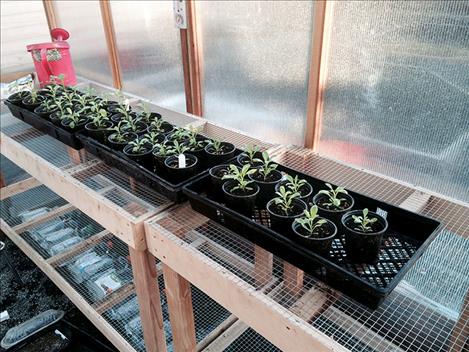Plan your garden now
Hey savvy news reader! Thanks for choosing local.
You are now reading
1 of 3 free articles.
This is the time to plan your 2017 garden. Seed racks will be in garden stores soon. Nowadays there are several companies selling organically grown seeds, some of them grown right here in the Flathead area. January is an excellent time to test the germination rate on your saved seeds. You can get a rough estimate of percentage if you sprout some now. Put 10 seeds folded into a moist paper towel. Place the moist towel on a plate, loosely covered with plastic wrap or waxed paper and put it in a warm place to test germ. The top of the refrigerator is a convenient spot to do this. If nine out of 10 seeds germinate you can bet on about a 90-percent germ. If a variety germinates poorly, you can plant extra seeds if you have them, or buy fresh seed. Also, check past records and eliminate any varieties that you did not like, or did not do well in your garden. Composted manure can be spread on vegetable beds, right on top of the snow if you want. Spring melt and rains will draw nutrients down into the soil. This month is a good time to repair garden tools, and obtain or make plant supports and cold frames. Locate frames and hotbeds for winter/spring growing outside in sunny, protected locations.
Check stored fruits and vegetables for spoilage. Watch cold frames; admit air on days when the temperature goes above freezing and be sure to cover them at night. Clean and weed lettuces and other winter greens growing in cold tunnels or frames. Use leftover Christmas tree boughs to mulch perennials, strawberries, roses, etc.
Prepare any planned garden designs. Be sure to rotate planting locations of vegetables and flowers every season for best health and disease prevention.
Indoors, sow strawberries and perennials early. Beginning Jan. 15, sow cauliflower and cabbage seed inside for growing in frames. Sow eggplant, onions, leeks, and early peppers. Sow perennial herbs: oregano, thyme, feverfew, Greek oregano, lavender, rosemary, chives, chamomile, hyssop, horehound, catnip, parsley, rue, lemon balm and salvia.
Harvest winter greens from frames and tunnels as well as spinach, lettuce, kale, chard, onions, parsnips, leeks and carrots.
Sow primrose and auricula seed in a cool greenhouse; protect auriculas from severe frost and rains. Ventilate auriculas and other alpines in the greenhouse; keep plants on the dry side as they will be dormant. Prepare to top dress containerized plants (in a cool greenhouse) with manure or compost in February.
Ventilate sweet violet frames daily; pick off dead foliage and keep the glass clean. Transfer potted sweet violets, pansies and violas to the greenhouse to flower. Other plants (previously potted) to force inside now include: honeysuckle, roses, jasmine, carnations, sweet William, wallflowers, stocks, narcissus, ranunculus, early dwarf tulips and lily of the valley. Take cuttings of geraniums and fuchsias. Force potted strawberries (potted in September) in hotbeds or the greenhouse. Check winter mulches and covers; mound up snow to keep perennials and roses protected from dry cold.
Have a great gardening year in 2017.
















